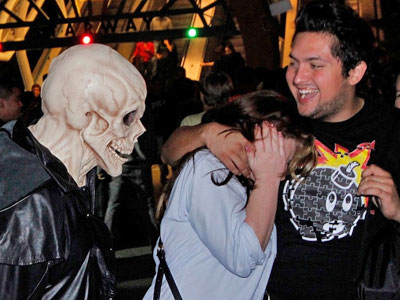So you cover financial services and figure there’s no way you can scare up a Halloween-related story on your beat?
Think again! How about a business feature on specialty insurance coverage for haunted houses, and corn mazes? I bet if you Google “haunted house insurance” and a geographical term for your region, you’ll find at least one provider; it’s a neat twist on seasonal financial coverage of Halloween and related business endeavors events from harvest festivals to corn mazes.
Even health care writers might find an angle, vis a vis injuries and hazards suffered at these thriller venues — do hospitals gear up for twisted ankles, panic attacks and other hazards of being scared silly? And what about workers? Haunted houses appear to generate a brisk business for personal injury lawyers; you could check out this facet if you cover workplace issues, the legal industry or even, I suppose, personal finance.
Here’s a Huffington Post story about haunted house workers; it’s a bit dated but might give you some tips for talking with haunt operators, workers comp experts and others in your region. Even if you cover the automotive or transportation industry, I can think of an angle: Check in with collectors of classic hearses or “professional cars” as they are known in the trade; it’s a lively niche among serious motorcar enthusiasts — and a moneymaking one at that, for those who lease out their cars this time of year for haunts, parades and other events. Start with the forum of the Professional Car Society and Google hearse clubs for your area.
I think one of the best possibilities this year for business journalists is to dig a bit deeper in the business model of running a haunted attraction, which appears to be a growing industry but still one in which profits can be pretty ghostly, if any.
The Haunted House Association says about 2,000 admission-charging haunted Halloween attractions are open each year, and that ticket prices have grown from $4-$6 in the 1990s to $15-25 today. But, the association says, most haunts admit fewer than 10,000 visitors — so it appears operators aren’t exactly making a killing after paying vendors, operations staff and actors. Why not ask some haunt operators to open their books and reveal how their business model works? If any are turning enough of a profit to make a living for their operators, how do they do it?
Of course, like any growing industry the haunt business generates trade for suppliers and vendors; you can find leads to vendors on the Haunted House Association’s website as well as on the site of HauntWorld, the major industry trade group, which operates a big conference each year. You also can check out that site for links to regional conferences which in turn might lead you to local suppliers. How’s the business in fake blood and gore these days, or the royalty issues for screams and groans? What’s the latest in technology for sound effects and moving parts in haunted houses?
And get this: at least one company, Hauntrepreneurs, offers its design and consulting services to would be purveyors of thrills and chills. What is the market for designers of seasonal attractions, from horror haunts to Santa’s workshops?
Haunted Attraction magazine offers some interesting insights. And last, I just have to mention this company I interviewed last year, because the name might give you a good laugh: Pumpkin Embalmer. The owner says his potion will keep jack-o-lanterns looking good for weeks, and he uses his classic hearse car in parades and such to promote the product. See if you can find a similarly picturesque entrepreneur in your haunted forest!











